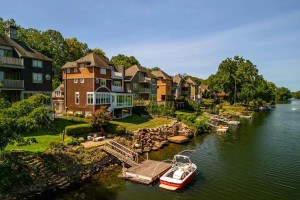Urban Archaeology: Wooden Street Unearthed in South Philly
As it turns out, the 200 block of Camac Street isn’t the only wooden street in Philadelphia.
According to the most recent newsletter from the Dickinson Square West Civic Association (DSWCA), repaving efforts from the Streets Department unearthed a stretch of what is believed to be original wooden blocks in the parking lanes that flank the 400 block of Reed Street (map), adjacent to the former Mt. Sinai Hospital site.
The newsletter details the conversations between DSWCA and David Perri, Street Commissioner: “’The paving work is stopped until an appropriate course of action is determined. We will evaluate the situation and report findings. Unlike Camac Street which was replaced many times over at least some of these wood blocks could be original. I would advise folks to be careful handling the blocks as they were likely coated in creosote.’”
Visibly, some of the “bricks” appear well-worn and splintered, while others are neatly packed into tight rows.
“These blocks were so dirty, you wouldn’t know that they were wood. One of the neighbors noticed it, cleaned it up and later confirmed it,” Perri later told Property, while strongly advising not to pick up the Creosote-soaked blocks. “It’s not a material you want to expose yourself to.” Creosote is toxic preservative historically used as a pesticide and to treat wood, and the Coal-Tar variety is commonly found in railroad ties, utility poles and, most likely, these (potentially century-old) wood pavers.
Unlike the square blocks on Camac Street, the newly discovered blocks are 4-in by 8-in and give the illusion of being a piece of traditional cobblestone, according to a neighbor. Perri said that they were thinking that those were the common dimensions used to build wooden streets in the early 1900s when they restored Camac Street, and that, for the first time, the Reed Street find gives them “positive confirmation” of this method. “We’re excited because this is the first one that we’ve found that has the orginal wood blocks in place,” said Perri, “We believe they’re original.”
It’s a delicate situation, as the street needs to be paved or repaired, but this is a rare find that neighbors feel needs to be preserved in some way.
“Because this situation is so unique, we’re trying to figure out some sort of gesture to identify that wood blocks were found on this particular street,” Perri told us. An early idea includes installing a small section of modern wood blocks on the street.
While those details are being smoothed out, about 40- or 50-square-feet worth of blocks will be removed in order to see if a museum would be interested in displaying the original street construction as a example of early transportation infrastructure.
Believe it or not, one of the most common ways to preserve historic streets is to simply re-pave them with asphalt, kind of like saving it for later.
Kim Broadbent, historic preservation planner with the Philadelphia Historical Commission, said that the Streets Department hasn’t brought them into the loop yet as it pertains to 400 Reed Street, but that it’s common practice to repave the street. “Should the Streets Department ever have funding to remove the paving and restore the street, they could do that.” The commission would then work with the Streets Department during the restoration process.
Perri explained that they’ll probably end up removing the sections of wood blocks that are rotted and then fill in the larger holes. After that, they will put an asphalt overlay on top of the street.
So, should we expect more of these finds as the city continues with its massive repaving project? “I would not be surprised,” said Broadbent. “I think when asphalt opens ups and you’re walking along in the city, it’s not uncommon to see Belgian blocks that were paved over.”
Perri confirmed that they usually find granite blocks during the milling process, which removes the top inch-and-a-half to ready the road for a new surface, but this discovery is completely different: “It’s up there with the wooden water mains that get found … It’s a really neat find.”
“I was kind of shocked,” said Ted Savage, DSWCA’s president, who cleaned up one of the bricks to get a closer look, an action he later cautioned against. “It’s absolutely beautiful wood.” Here’s a closer look:
UPDATE:
A reader named Mike Kania sent us a picture of another wooden street he discovered back in August. “This is on Marlborough St right next to the church on the corner of Richmond [map],” Kania wrote in an email. “A lot of that area is torn up due to I95 bridge work so I’d think it won’t be paved over till that is done.”
Here’s the scene from August, note the chipped blocks and the likely 4-in 8-in dimensions:
Have you seen the wooden street in Fishtown, or any others that we (and the Streets Department) should know about?
- 400 BLOCK OF REED STREET IS WOOD [Dickinson Square West Civic Association]
Camac Street’s wooden blocks repaired [Eyes on the Street]





